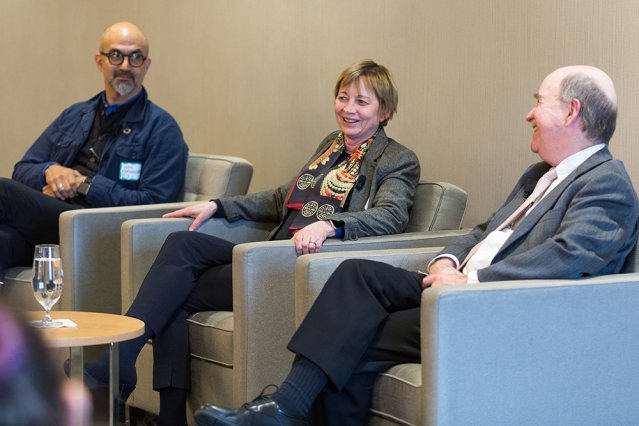
MIT’s Plan for Action on Climate Change, released by President L. Rafael Reif in October 2015, has already begun to catalyze new research on climate issues at the Institute and a tighter focus on building a sustainable campus here in Kendall Square. But MIT will be passing up important opportunities to make an impact on climate change if it does not look beyond its own borders and forge partnerships far outside the realm of academic research.
That was the message MIT Vice President for Research Maria Zuber brought to MIT Climate Night as the university’s environment and sustainability groups gathered on April 25 to discuss climate issues on campus.
“One of the pillars of MIT’s Climate Action Plan,” said Zuber at the event, “is that we’ve decided that we should engage with all comers. Climate change represents a global problem, and the only way that we can really address it is to partner with as many organizations and people as we can.”
Zuber appeared with John Fernández, director of the MIT Environmental Solutions Initiative (ESI), and Robert Armstrong, director of the MIT Energy Initiative (MITEI), to discuss their personal experiences working on climate issues and where they believe the Institute can be most influential. All three agreed that, while MIT’s role as a powerhouse of basic research is important, it has been equally energizing to delve into practical, policy-based engagement with unexpected partners.
Fernández, for example, pointed to ESI’s collaboration with the nonprofit Center for Coalfield Justice in Greene County, Pennsylvania, a region where the coal industry has long been the dominant employer. While residents of Greene County can be resistant to environmental groups, he said, it’s not because they refuse to accept that their economy is changing. Instead, they can see keenly that more prodding to abandon coal is not the help they need.
“Everyone knows there’s going to be a transition,” said Fernández. “In fact, maybe they know better than anyone, because they’ve seen companies go bankrupt and pull up and move.” Coalfield Justice and ESI have been able to work constructively with residents because their research centers on finding paths to a humane economic transition, and communicating those paths to help the county weather the decline of its major industry.
Armstrong, meanwhile, discussed MITEI’s work with developing countries through the Tata Center for Technology and Design, to bring energy solutions to areas without energy access, including in India and sub-Saharan Africa. “These regions are in energy poverty and in desperate need of getting energy in a carbon-free way so that they can engage in the global economy,” Armstrong said. Here, innovations in financing small grids can have a triple benefit: improving quality of life, bringing in new work opportunities, and adding carbon-free energy in countries where the dirtiest fossil fuels might otherwise expand.
Armstrong also takes heart from MITEI’s ongoing conversations with established energy companies, some of which are beginning to make large investments in carbon-free power. “Part of the Plan for Climate Action has been engaging with industry,” he said, citing cement, chemicals, and metals as important energy-intensive sectors to decarbonize. “This has to be economy-wide,” he said. “We’re working to engage a broader range of industries.”
MIT Climate Night was co-sponsored by ESI and MITEI and brought together representatives from more than a dozen departments, centers, and student and alumni groups whose missions include climate action on campus and beyond. It was the first real-world event to grow out of the MIT Climate Portal, an online community for engagement on climate science and solutions.
Attendees joined discussions on topics that encompassed both a global context and actions MIT can take on its own, including the energy transition, climate finance, and carbon offsets. They also took in the three headline speakers’ thoughts about how the Institute can not only advance research, but also inspire change in the wider world. As Zuber recalled, the flourishing environmental movement of the 1970s needed both scientific discovery and a mass change in consciousness, inspired by moments like the Apollo space missions, to succeed.
Zuber projected a single slide for her talk at Climate Night: the famous “Earthrise” image taken from the Apollo 8 spacecraft in December of 1968 — seven months before the Apollo 11 lunar landing and just over a year before the first Earth Day in April 1970. “Images are important, and I spend a lot of time thinking about, ‘What is the image, what is the message, that it’s going to take to globally change opinion … so that we’re all taking better care of our Earth?’” she said. “This image of actually seeing the fragile Earth from space and everything that we know and love sitting out there in space, alone, was one of the things that really inspired the environmental movement.”
MIT’s climate community may need little encouragement to look outside their own silos, as the diverse attendees who came to Climate Night to meet new allies on campus can attest. “I think that’s fundamentally in the DNA at MIT,” noted Armstrong in his opening remarks. “I’ve found that to be extraordinarily stimulating [at MITEI], both because of the enthusiasm across campus for addressing energy, but also because of the enthusiasm for working together across disciplines.
“I don’t know anywhere else among universities where there’s this low a barrier to collaboration.”
The audience at MIT Climate Night submitted more questions than the speakers could answer during the event. For responses to more audience questions from the offices of the Vice President for Research, ESI, and MITEI, visit climate.mit.edu over the coming weeks.
Press inquiries: miteimedia@mit.edu